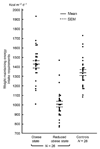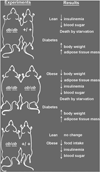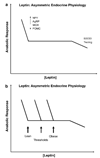Molecular physiology of weight regulation in mice and humans
- PMID: 19136999
- PMCID: PMC2682360
- DOI: 10.1038/ijo.2008.245
Molecular physiology of weight regulation in mice and humans
Abstract
Evolutionary considerations relating to efficiency in reproduction, and survival in hostile environments, suggest that body energy stores are sensed and actively regulated, with stronger physiological and behavioral responses to loss than gain of stored energy. Many physiological studies support this inference, and suggest that a critical axis runs between body fat and the hypothalamus. The molecular cloning of leptin and its receptor-projects based explicitly on the search for elements in this axis-confirmed the existence of this axis and provided important tools with which to understand its molecular physiology. Demonstration of the importance of this soma-brain reciprocal connection in body weight regulation in humans has been pursued using both classical genetic approaches and studies of physiological responses to experimental weight perturbation. This paper reviews the history of the rationale and methodology of the cloning of leptin (Lep) and the leptin receptor (Lepr), and describes some of the clinical investigation characterizing this axis.
Conflict of interest statement
The author has declared no financial interests.
Figures








References
-
- Chen P, Baas TJ, Mabry JW, Dekkers JC, Koehler KJ. Genetic parameters and trends for lean growth rate and its components in US Yorkshire, Duroc, Hampshire, and Landrace pigs. J Anim Sci. 2002;80:2062–2070. - PubMed
-
- Deeb N, Lamont SJ. Genetic architecture of growth and body composition in unique chicken populations. J Hered. 2002;93:107–118. - PubMed
-
- West DB, Boozer CN, Moody DL, Atkinson RL. Dietary obesity in nine inbred mouse strains. Am J Physiol. 1992;262:R1025–R1032. - PubMed
-
- Shadid S, Jensen MD. Nutrient partitioning. In: Bray GA, Bouchard C, editors. Handbook of Obesity. Etiology and Pathophysiology. 2nd edn. New York: Marcel Dekker; 2004. pp. 753–766.
-
- Bjorntorp P. Body fat distribution, insulin resistance, and metabolic diseases. Nutrition. 1997;13:795–803. - PubMed
Publication types
MeSH terms
Substances
Grants and funding
LinkOut - more resources
Full Text Sources
Medical
Miscellaneous

